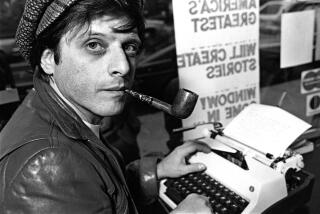‘Will Eisner’ by Michael Schumacher
Although he neither coined the term “graphic novel” nor invented the form, Will Eisner ranks among America’s most celebrated and influential sequential artists. The creator of “The Spirit” (a comic book hero who solved crimes without recourse to superpowers or high-tech gadgetry), “The Contract With God” (depicting tenement life during the Depression) and three books on writing and drawing sequential art, Eisner has influenced a generation of artists, writers and animators, including Jules Feiffer, Art Spiegelman and Brad Bird.
William Erwin Eisner was born in New York City in 1917. His artist manqué father encouraged his love of drawing; his discouraged, practical mother urged him to find a more secure career than art. He studied at the Art Students League under George Bridgman and Robert Brackman, whose influence is readily apparent in his work, and began his professional career doing illustrations for pulp magazines and early comic books.
In many ways, Eisner’s artistic beginnings were typical of the generation of Jewish artist-writers who helped to create the comic book as we know it, especially the superhero and crime genres. But unlike many of his contemporaries who continued to work for minimal, by-the-page salaries, Eisner organized his own studios and paid other artists to work for him, including Feiffer and Mad’s Dave Berg and Al Jaffee. He also recognized the potential of the comic book as a teaching tool, illustrating numerous publications for the U.S. military.
Schumacher doesn’t really seem to grasp what sets Eisner’s considerable output apart. What was it about “The Spirit” that attracted Bird, Tim Burton, John Musker and other bright young animators? Viewers who endured Frank Miller’s wretched “Spirit” feature film probably wonder why anyone would bother reading the comic; Schumacher mentions only that the film premiered in 2008.
Instead, he fills pages with tangential, sometimes completely irrelevant details. Does anyone really care that Eisner’s friend and later publisher Dennis Kitchen abandoned ROTC in college because he was allergic to the wool uniforms? A discussion of the young readers of the underground comix — many of whom became Eisner fans — includes such portentous pronouncements as, “To teenagers and young adults schooled in the hurricane mixture of rock ‘n’ roll, radical politics, free and open drug use, and casual sex, the more excessive the comic book could be the better. There was no room for compromise in a country engaged in an extremely unpopular war, where political assassinations destroyed any faith they might have had in their futures, where a dissident voice might be silenced by law enforcement officials using petty drug busts and subsequent incarcerations as a means of eliminating protestors.… Freedom of speech, although wounded, wasn’t dead.”
Schumacher wastes the reader’s time with these digressions and also omits important information. Eisner’s daughter Alice died of leukemia when she was 16. The artist reacted to her passing with as much rage as grief. Schumacher explains that Eisner later channeled his fury at the brevity of her life into “The Contract With God,” in which the faith of the pious Frimme Hersh is shattered by the premature death of his adopted daughter Rachele. But Eisner also had a son, John. Schumacher mentions his birth, then John vanishes from the narrative except for two brief comments: He had ceased living at home at one point, and he suffered from mental illness. What ultimately became of John or of Ann, Eisner’s widow, is left for the reader to discover on his own.
Too often, Schumacher talks about material that the book should have illustrated. He quotes Eisner’s praise for Abe Kanegson’s lettering in “The Spirit” — “He added a dimension of quality that typesetting could never get. His lettering is clear and legible, and in addition it lends warmth to the visuals.” — but doesn’t include any examples of that brilliant lettering. Although this book contains 50 black-and-white illustrations, most of them are printed quite small. Even the largest plates in the 16-page color insert are smaller than the original comic book covers, and most of the color artwork is undated.
Eisner has already been the subject of one biography, Bob Andelman’s “Will Eisner: A Spirited Life,” and a documentary, “Will Eisner: Portrait of a Sequential Artist” by Andrew D. Cooke and Jon B. Cooke. He gave extensive interviews during the latter part of his career and wrote introductions to many of his graphic novels (which are being reprinted by W.W. Norton). His work has been discussed in numerous books, starting with Feiffer’s seminal “The Great Comic Book Heroes.” To this already considerable body of material, “A Dreamer’s Life in Comics” adds little.
Solomon is the author, most recently, of “The Art of ‘Toy Story 3’ ” and “Tale as Old as Time: The Art and Making of ‘Beauty & the Beast.’ ”
More to Read
The biggest entertainment stories
Get our big stories about Hollywood, film, television, music, arts, culture and more right in your inbox as soon as they publish.
You may occasionally receive promotional content from the Los Angeles Times.










